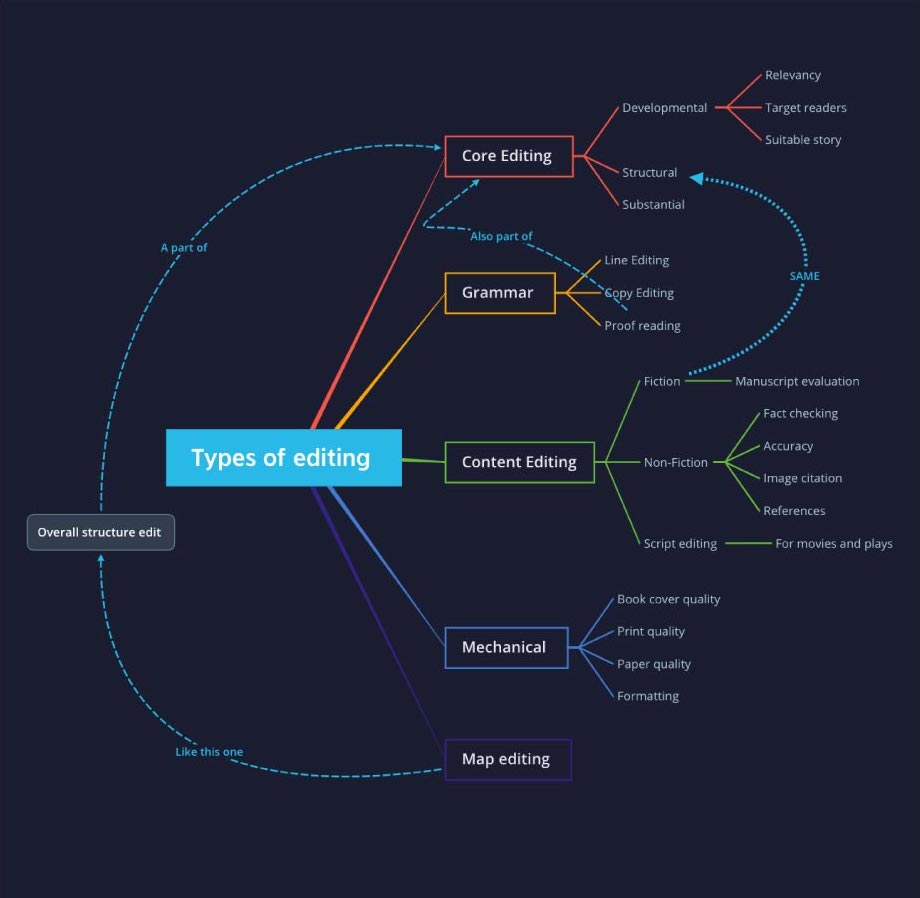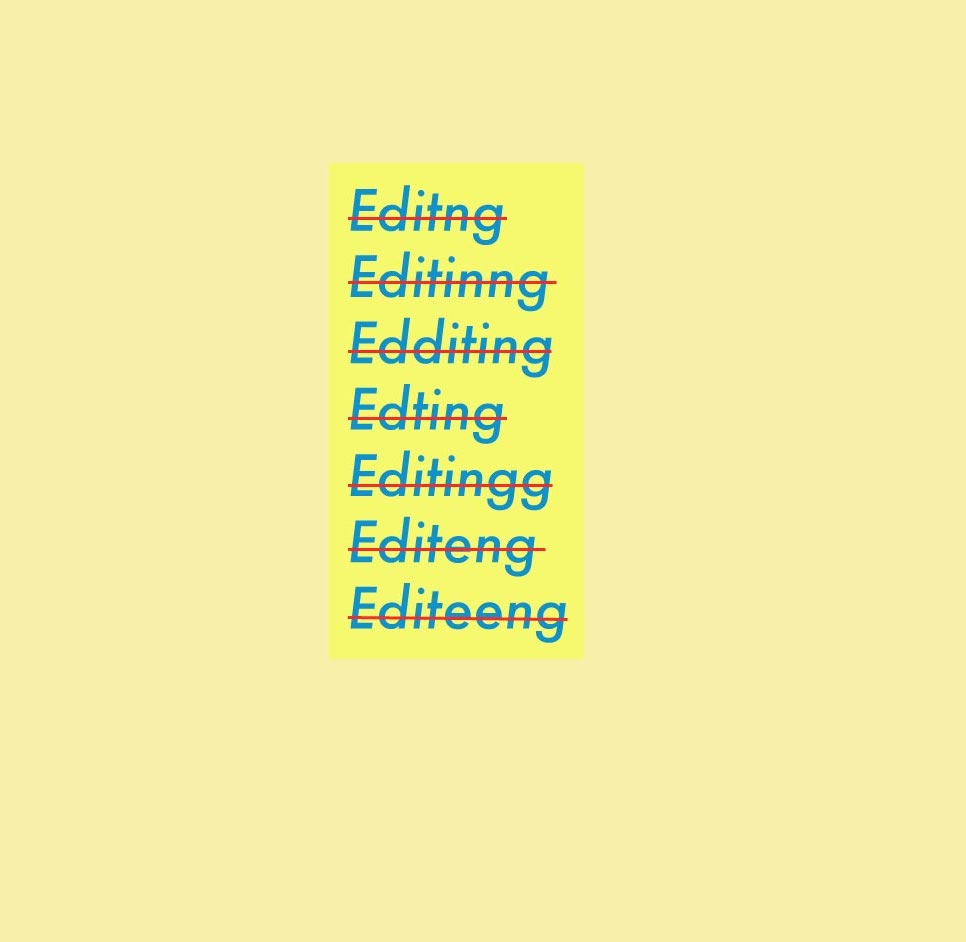If you are a beginner in the world of writing, chances are that you have never heard about the different types of editing. For most, editing means just eliminating the unnecessary and erroneous components of the draft. You’d be confounded to find that there are more than 10 types of editing. And this article will detail that.
Before we begin, we must clear on the fact that there is no definitive boundary that separates these types of editing. As a web, these methods of editing are all interconnected, operating closely and as a whole.
Then there are sub-parts of some types of editing (which will be discussed in the article). There are also instances where one method of editing changes to differences in the context of the content of the draft.
These are the different types of editing that this article shall look at:
- Structural editing
- Substantial editing
- Developmental editing
- Line editing/stylistic editing
- Copyediting
- Proofreading
- Mechanical/Quality editing
- Content editing
- Map editing
The core editing
Core editing contains three major types of editing; structural editing, substantive editing, and developmental editing. The reason why it’s called core editing is that it focuses on the entire structure of the plot. This is what each of these three core editing focuses on.
Structural editing: It looks at the overall structure of the story, in its entirety. The plot, the theme of the story, character development, pacing, etc, everything is checked in structural editing. The goal of this edit is to make a cohesive story with each element staying relevant to the entire story. It also makes sure that these elements are consistent without any error.
Substantial editing: In a nutshell, in substantial editing, the editor is in charge of the entire novel. Instead of pointing out the required changes, the editor takes the liberty of making substantive changes in the novel. This can include minor changes like character traits, unnecessary elements to major changes like removing entire sub-plots, paragraph rewrites, etc.
Developmental editing: This editing is done before the novel is even written. A developmental editor (usually the chief editor) guides on what the theme, storyline, and setting of the plot should be. This is done to maximize the reach and success of the novel. What do the targeted demographic likes in the novel, which story types (like fantasy, romance, etc) are popular, etc? All these factors are considered before planning the book. Developmental editing is like conceptual editing.
Content editing: Content editing is very similar to structural editing, but instead of working on fiction, content editing is about looking at the overall structure of a non-fictional book. There are different parts of content editing as well, but the major portion looks at whether the structure of the non-fictional content works as desired or not. Whether the chapters and units of the book gel together? Whether the components of the book are relevant to the theme or topic of the book. All these things lie in the domain of content editing. Content editing is the structural editing of non-fictional books.

You can read more about structural editing and what elements it focuses on in detail here.
Grammatical editing
As the name suggests, this section of edition works on the grammatical aspects of the draft. Grammatical editing focuses on the typos, errors, missed words, wrong verbs, unnecessary adjectives, tautology, amateur writing, the tonality of the sentences, etc. Grammatical editing looks at the fragments of the entire book, instead of looking at the overall structure.
Copyediting: Copyediting eliminates all the grammatical errors from the draft. Spelling mistakes, word repetition, incomplete sentences, usage of wrong words, etc. This is what most people think the entire process of editing is; just remove the grammatical errors. Do note that it is entirely different from copywriting. The article linked before has the difference explained.
Line editing or Stylistic editing: Line editing is the meticulous line-by-line editing of the novel. But what does it edit? Instead of looking for grammatical errors, line editing looks at the quality of the sentence. How is the wording, what kind of adjectives have been used, are they relevant or unnecessary. Is there a tautology, like his own car, is the writing style consistent? All these are checked inline editing. This is why it’s also called stylistic editing.
Proofreading: Proofreading could be best described in editing the edited work. It is checking whether the final product after the editing is finished has come out the way it was intended to be or not. Although I have put proofreading in the grammatical editing section, this isn’t exclusive to it. Proofreading is done in all types of editing. It is done after structural editing (to see if structural editing worked or not), after line editing, and copyediting as well.
Script editing: Nothing really to explain here, as the name says it all. This is editing a script for a play or a movie and it has similar content as in normal editing. There is one difference. Here the editor has to keep in mind that the scenes have to be played by actors. The content, dialogues, scenes must be executable and presentable.
Components of content editing: Some small elements come under content editing. These little editing components are more relevant to non-fictional books, but they are employed in fictional books as well. The components are Fact-checking, the accuracy of the information given, citation of images or quotes, and proper reference.

Also read: How to use and build narrative tension to engage the readers’ interest?
Mechanical or Quality editing
This section of editing deals with how the content is presented, as opposed to what the content is. Even though the editor is concerned with the content of the book, the physical aspects of the book can translate to bad or good sales figures. So it is necessary to check these physical aspects of the book as well:
Book cover quality: Hardcover or paperbound, the quality makes a lot of difference. No one wants to buy a book with a tattered and creased book cover. The editor (or the author sometimes) makes sure that the publication uses good quality material to make the book.
Paper quality: I hate paper that turns yellow after you have completed and kept the book on the shelf. Also, creamy, thick papers are much more preferred than white, transparent ones.
Fonts, spacing, formatting: Imagine this article where the fonts are 5 times smaller and so closely spaced, you’d think the whole article is written using symbols. The writer or the editor must make sure that the fonts are great for the medium ( serif for print, sans serif for digital), well-spaced, properly formatted for comfortable reading.

Map editing
Map editing is a conceptual editing method, just like developmental editing is. But unlike developmental editing, where the editing is done before the book is written, map editing is done after the book is written.
Map editing focuses on the way information is presented. The flow of information, how easy it is for the readers to take in all that, etc. It also helps the author in seeing the overall structure of the book, in a pictorial perspective. I have attached an image that shows the map editing for this article. I used an application called XMind, but for people who don’t have an app, old-fashioned pen and paper will work just fine.

Closing remarks
Editing is a time-taking and complex process. Imagining this mammoth of a process in terms of fragments is good for theoretical understanding, but bad for practical usage. Remember, no editing works separately.
For example, copyediting and line editing go hand in hand, as it is much easier and faster to check both the line composition and grammatical error. The same goes for structural and substantive editing.
The best way for new writers to edit their work is first going for the grammatical editing, then reading their work loudly to check if something seems off. Finally, using mapping to see the entire structure of the draft. With practice, editing would be a breeze.







